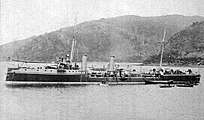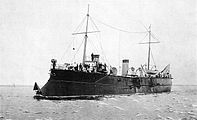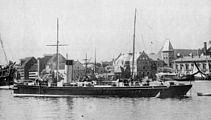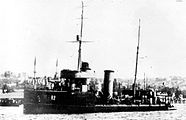Torpedo cruiser
Torpedo cruisers were developed after 1880 as a torpedo boat defense vehicle, some of which were also referred to as torpedo cannon boats . They were armed with several torpedo tubes , guns up to 12 cm caliber and automatic cannons. They should accompany the high seas combat fleet and protect them from attacks by enemy torpedo boats. Because of their water displacement of up to 1500 tons, some of them were also classified as fleet cruisers or 3rd class cruisers .
General
Torpedo cruisers were mainly used in the fleets of Austria-Hungary , Russia , Great Britain , France , Italy and Japan . Comparable ships in the German Imperial Navy and the French Navy were mostly referred to as Aviso .
The first sinking of a larger warship with a self-propelled torpedo was not achieved by a torpedo boat, but by the torpedo cruiser Almirante Lynch (713 t), which sank the central battery ship Blanco Encalada (3540 t) on April 22, 1891, during the Chilean civil war . One of six torpedoes hit the battleship, which sank in less than ten minutes.
The five ships of the Swedish Örnen class were also officially referred to as “Torpedkryssare” . The ships built in Sweden came into service with the Swedish Navy between May 1897 and November 1900. These 800 t displacement ships were 69 m long and 8.2 m wide and reached a top speed of 20.5 kn. They were armed with two 120 mm and four 57 mm cannons and a torpedo tube. The Örnen and the Jacob Bagge last remained in service as cadet school ships until 1947.
The Swedish Örnen
Due to the increasing use of the faster torpedo boat destroyers, the importance of the torpedo cruisers steadily declined, so that after 1900 their construction was given up, especially for the large navies.
British torpedo cruisers and torpedo gunboats
The Royal Navy received torpedo cruisers of the Scout class (1600 t, 17.6 kn) and the Archer class (1770 t, 17.5 - 18 kn, 8 ships) and ordered over to the HMS Rattlesnake (1886, 550 t) 30 "torpedo gunboats", especially the 13 boats of the Sharpshooter class (1888/1891, 735 t), the eleven of the Alarm class (1892/1893, 810 t) and the last the five boats of the Dryad class (1893 / 1894, 1070 t). Two of the Sharpshooter class were assigned to the Royal Indian Navy and two to the Australian station . From 1904 the first boats retired from active service, five were converted into minesweepers from 1908 to 1909 and still took part in the First World War. The first boats from the following alarm class were eliminated in 1905; six of this class were converted into minesweepers in 1909. Among them the HMS Speedy , the only three-chimney of this class, which was built by John I. Thornycroft & Company with water tube boilers and is considered to be one of the original ships of the torpedo boat destroyer . Four of the final Dryad class were also minesweepers at the beginning of the World War, only HMS Hazard remained a submarine tender .
Torpedo cruiser of the Austro-Hungarian Navy
The Austro-Hungarian Navy procured various vehicles as torpedo cruisers. The first torpedo ships of the Kriegsmarine were the yacht-like ships SMS Zara , Spalato , Sebenico and Lussin , which came into service between 1881 and 1884 and were still equipped for auxiliary sails. In the course of their service life , the torpedo ships SMS Panther and SMS Leopard , which were then ordered from Armstrong in Elswick , were referred to as cruisers, followed by their own replica with the SMS Tiger , which was also known as torpedo ram cruiser . These light ships were followed by the heavier torpedo ramming cruisers A and B , also built in Trieste , which, as SMS Kaiser Franz Joseph I and SMS Kaiserin Elisabeth , were typical protected cruisers . The following torpedo Rammkreuzer C was completed as armored cruiser SMS Kaiserin and Queen Maria Theresia . Starting in 1886, the Navy besides the usual ordered torpedo boats and seven small torpedo boats (see Meteor class , Satellite , magnetic ) from different manufacturers and according to different plans that can torpedo gunboats would have called internationally and forerunner of until 1905 procured by the Navy destroyer were .
Russian torpedo cruiser
The first nine torpedo cruisers of the Imperial Russian Navy joined the fleet between 1889 and 1897. They were the 600 t lieutenant Ilyin and the similar Captain Saken (742 t) built for the Black Sea Fleet . These two single ships built in Russia were followed by six more boats of the Kasarski class of 430 t based on a Schichau design and finally the Abrek of 535 t, built in Finland .
Schichau built the first three boats ( Kasarski , Wojewoda , Possadnik ) in Elbing himself, the Griden was built in Nikolajew for the Black Sea. Two of the boats, Wsadnik and Gaidamak , were built by W. Crichton in Abo according to the German plans. These two were relocated to the Far East in 1894 as the first modern ships to reinforce the Pacific Squadron , supported from the Mediterranean by the armored frigate Pamjat Asowa , and were lost in Port Arthur . The Japanese raised both boats and kept them in service as Makikumo and Shikinami until 1914 .
Already during the Russo-Japanese War , the construction of 24 similar, more than 600 t large destroyers according to German plans for the Imperial Russian Navy began. Until October 10, 1907, these first real destroyers of the Imperial Russian Navy were called torpedo cruisers ( Минные крейсера ). Vulcan was behind the eight Ukraina-class destroyers and the four Finland-built Okhotnik-class destroyers . The Germania shipyard in Kiel planned the four destroyers of the Wsadnik class , two of which they built themselves, and planned the four similar boats of the Lieutenant Shestakov class for the Black Sea. The Emir Bucharski class , which the Schichau-Werke designed and for which they manufactured parts, were all completed in Russian shipyards. Schichau himself delivered the replicas of the smaller kit class . From May 1905 to 1907, the 20 boats from the Baltic Sea all came into service as torpedo cruisers. The four Black Sea boats were still under construction and did not come into service with the fleet until 1909.
The 24 large destroyers are also referred to by the Russian side as the Dobrowolez (volunteer) class, which takes the name of the procurement committee for the reinforcement of the Russian fleet through voluntary contributions .
Further examples
Torpedo cruiser:
- SMS Panther , SMS Leopard (Austria-Hungary)
- Tromp (Netherlands)
- Jacob van Heemskerck (Netherlands)
Shortly before the outbreak of the Second World War , the Dutch Navy put two combat ships, also known as torpedo cruisers (officially Flottieljeleider = flotilla leader ), into service, which were smaller and less armored than the light cruisers of their time.
The term torpedo cruiser is sometimes used for the large destroyers that were used in World War II.
Individual evidence
- ^ David Lyon; Rif Winfield: The sail & steam Navy list: all the ships of the Royal Navy, 1815-1889 , Chatham, London 2004, ISBN 978-1-86176-032-6 .













